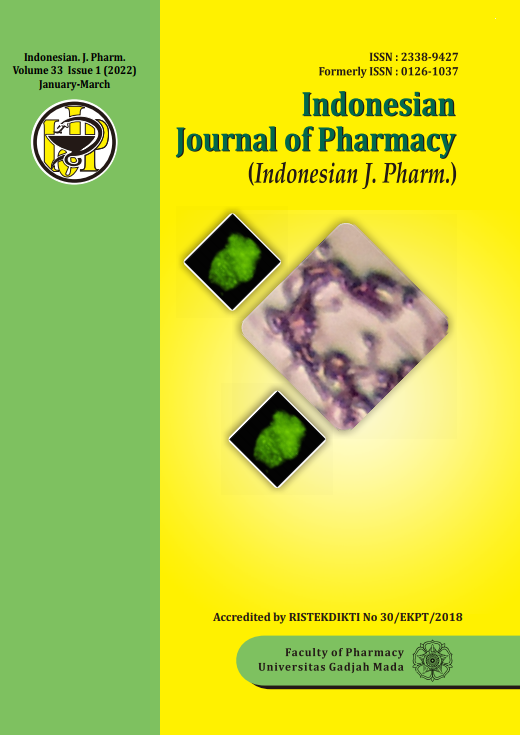Application of Ftir-Atr Spectroscopy in Combination With Multivariate Analysis to Analyse Synthetic Drugs Adulterant in Ternary Mixtures of Herbal Medicine Products
Abstract
To against the increasing number of adulteration reports in herbal medicine products in Indonesia, specifically Jamu in powder dosage form, a rapid, efficient, inexpensive method is required. This study was aimed to develop an approach for quantification and classification of an unadulterated herbal medicine product with synthetic drug (prednisone and metamizole) by combining FTIR Spectroscopy and multivariate calibration (PLSR and PCR) as well as discriminant analysis (DA). The spectra data of three individual types of reducing herbal pain products were scanned and collected by FTIR-ATR in the mid-infrared region and further analyzed by two multivariate calibrations to exhibit the optimum mode for quantification analysis of each sample reducing herbal pain product. Based on statistical parameter value, PCR analysis of each model demonstrated the highest value of R2 in both calibration and validation and the lowest value of root mean square of calibration (RMSEC) and root mean square of prediction (RMSEP). The discriminant analysis (DA) was also performed in this study to classify pure reducing pain herbal medicine products without any drugs contaminant and adulterated with synthetic drugs. The outcome of DA was shown by Cooman’s plot and DA could discriminate adulterated and unadulterated reducing pain herbal medicine products with 100% accuracy level. FTIR-ATR spectroscopy in the mid-infrared region coupled with chemometrics could be a potential analytical technique to detect synthetic drugs contaminant in herbal products.
References
Ariffin, S. H., A Wahab, I., Hassan, Y., & Abd Wahab, M. S. (2021). Adulterated Traditional-Herbal Medicinal Products and Its Safety Signals in Malaysia. Drug, Healthcare and Patient Safety, 13, 133–140. https://doi.org/10.2147/DHPS.S305953
Cebi, N., Yilmaz, M. T., & Sagdic, O. (2017). A rapid ATR-FTIR spectroscopic method for detection of sibutramine adulteration in tea and coffee based on hierarchical cluster and principal component analyses. Food Chemistry, 229, 517–526. https://doi.org/10.1016/j.foodchem.2017.02.072
Ching, C. K., Chen, S. P. L., Lee, H. H. C., Lam, Y. H., Ng, S. W., Chen, M. L., Tang, M. H. Y., Chan, S. S. S., Ng, C. W. Y., Cheung, J. W. L., Chan, T. Y. C., Lau, N. K. C., Chong, Y. K., & Mak, T. W. L. (2018). Adulteration of proprietary Chinese medicines and health products with undeclared drugs: Experience of a tertiary toxicology laboratory in Hong Kong. British Journal of Clinical Pharmacology, 84(1), 172–178. https://doi.org/10.1111/bcp.13420
Elfahmi, Woerdenbag, H. J., & Kayser, O. (2014). Jamu: Indonesian traditional herbal medicine towards rational phytopharmacological use. Journal of Herbal Medicine, 4(2), 51–73. https://doi.org/10.1016/j.hermed.2014.01.002
Fatmarahmi, D. C., Susidarti, R. A., Swasono, R. T., & Rohman, A. (2021). Identification and Quantification of Metamizole in Traditional Herbal Medicines using Spectroscopy FTIR-ATR combined with Chemometrics. Research Journal of Pharmacy and Technology, 14(8), 4413–4419.
Gitawati, R. (2013). Analisis Adulterasi Jamu Pegal Linu yang Diperoleh dari Pasar di Jakarta dan Sekitarnya (Analysis of Adulterated Jamu Pegal Linu Obtained from the Market in Jakarta). Buletin Penelitian Sistem Kesehatan, 16(3 Jul). https://doi.org/10.22435/bpsk.v16i3 Jul.3464
Irnawati, Riyanto, S., Martono, S., & Rohman, A. (2019). Determination of sesame oil, rice bran oil and pumpkin seed oil in ternary mixtures using FTIR spectroscopy and multivariate calibrations. Food Research, 4(1), 135–142. https://doi.org/10.26656/fr.2017.4(1).260
Miller, J. N., & Miller, J. C. (2010). Statistics and chemometrics for analytical chemistry (6. ed). Prentice Hall.
Mustarichie, R., Ramdhani, D., & Indriyati, W. (2017). Analysis Of Forbidden Pharmaceutical Compouinds In Antirheumatic Jamu. Asian Journal of Pharmaceutical and Clinical Research, 10(4), 98. https://doi.org/10.22159/ajpcr.2017.v10i4.16101
Riyanto, S., Martono, S., & Rohman, A. (2019). Analysis of palm oil as oil adulterant in olive and pumpkin seed oils in ternary mixture systems using ftir spectroscopy and chemometrics. International Journal of Applied Pharmaceutics, 210–215.
Rohman, A., Nugroho, A., Lukitaningsih, E., & Sudjadi. (2014). Application of Vibrational Spectroscopy in Combination with Chemometrics Techniques for Authentication of Herbal Medicine. Applied Spectroscopy Reviews, 49(8), 603–613. https://doi.org/10.1080/05704928.2014.882347
Rohman, A., Windarsih, A., Hossain, M. A. M., Johan, M. R., Ali, M. E., & Fadzilah, N. A. (2019). Application of near- and mid-infrared spectroscopy combined with chemometrics for discrimination and authentication of herbal products: A review. Journal of Applied Pharmaceutical Science, 9(3), 137–147. https://doi.org/10.7324/JAPS.2019.90319
Rooney, J. S., McDowell, A., Strachan, C. J., & Gordon, K. C. (2015). Evaluation of vibrational spectroscopic methods to identify and quantify multiple adulterants in herbal medicines. Talanta, 138, 77–85. https://doi.org/10.1016/j.talanta.2015.02.016
Vaysse, J., Balayssac, S., Gilard, V., Desoubdzanne, D., Malet-Martino, M., & Martino, R. (2010). Analysis of adulterated herbal medicines and dietary supplements marketed for weight loss by DOSY 1 H-NMR. Food Additives & Contaminants: Part A, 27(7), 903–916. https://doi.org/10.1080/19440041003705821








